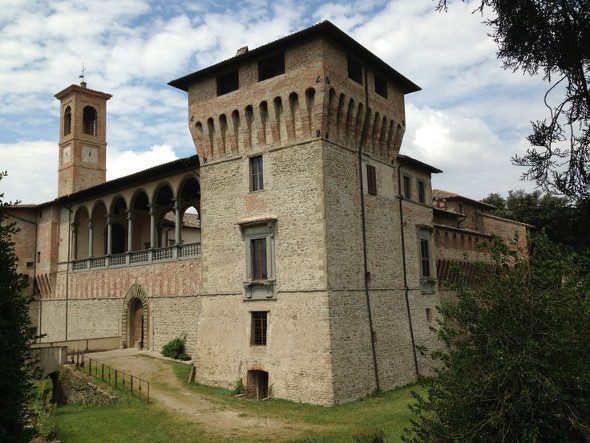▌ Discover San Giustino
#BELLAUMBRIA
San Giustino è oggi un paese d’aspetto moderno le cui attività principali sono l’agricoltura e l’industria metalmeccanica e alimentare. L’antica storia del borgo, quando fu feudo prima della famiglia Dotti poi di quella Bufalini, è testimoniata dal Castello Bufalini eretto nel 1492.L’ edificio, trasformato in magnifica villa dal Vasari, mostra all’interno decorazioni con grottesche attribuite a Cristoforo Gherardi e all’esterno un giardino con labirinto. E’ possibile inoltre ammirare qui dipinti di grande fascino come la “Madonna col Bambino e Santi” del Signorelli, una “Madonna” di Andrea del Sarto ed altre opere di Guido Reni.
Vuoi visitare San Giustino ? Scegli l’agriturismo che fa per te! >> Vai alla lista

>> Ci sono offerte in scadenza per hotel nella zona di San Giustino! Clicca e consultale subito.
A soli 2 km da San Giustino si trova l’ex Repubblica di Cospaia, una piccola striscia di territorio larga appena 700 metri e lunga circa 4 km, che, nata per un errore di confini tra lo Stato Pontificio ed il Granducato di Toscana, rimase “terra di nessuno” e fu indipendente dal 1440 al 1826. Nel suo territorio, nel 1575 fu coltivato il primo tabacco d’ltalia con seme portato dalla Spagna dall’Abate Nicolò Tornabuoni. Nei territori circostanti San Giustino sono stati ritrovati numerose vestigia di antiche ville romane: sembra che lo stesso Plinio il Giovane soggiornò a lungo nella località che ancora oggi porta il suo nome, Colle Plinio. Proprio su questo colle è stata costruita villa Cappelletti, un edificio neoclassico del XVII secolo, circondata da un ampio giardino.
Sempre nei dintorni si può ammirare villa Margherini Graziani di Celalba, splendida costruzione tardo-rinascimentale ottenuta nel 1616 dalla trasformazione di un antico castello. Nel 2004 a San Giustino è stato inaugurato il Museo Storico e Scientifico del Tabacco, il primo in Umbria e uno dei pochi in Italia, nato con l’obiettivo di conservare e valorizzare il patrimonio storico e culturale legato alla coltura di questa pianta che ha avuto un’importanza molto significativa per lo sviluppo economico e sociale dell’Alta Valle del Tevere.
“},{“lang”:”en”,”content”:”Nowadays, San Giustino is a town of modern aspect whose main industries apart from agriculture,are the metal-working and nutritional industries. Bufalini Castle, which was erected in 1422, testifies to the ancient history of this town, which was first feud of the Dotti, then of the Bufalini family. This building, which was transformed into a magnificent villa by the Vasari, contains, in the interior, decorations in the grotesque style which have been attributed to Cristoforo Gherardiand, and outside, gardens and a labyrinth. Here it is also possible to admire very fascinating paintings such as the “Madonna with Child and Saints” by Signorelli, a “Madonna” by Andrea del Sarto and other works of art by Guido Reni.
“},{“lang”:”es”,”content”:”Nowadays, San Giustino is a town of modern aspect whose main industries apart from agriculture,are the metal-working and nutritional industries. Bufalini Castle, which was erected in 1422, testifies to the ancient history of this town, which was first feud of the Dotti, then of the Bufalini family. This building, which was transformed into a magnificent villa by the Vasari, contains, in the interior, decorations in the grotesque style which have been attributed to Cristoforo Gherardiand, and outside, gardens and a labyrinth. Here it is also possible to admire very fascinating paintings such as the “Madonna with Child and Saints” by Signorelli, a “Madonna” by Andrea del Sarto and other works of art by Guido Reni.
“},{“lang”:”de”,”content”:”Nowadays, San Giustino is a town of modern aspect whose main industries apart from agriculture,are the metal-working and nutritional industries. Bufalini Castle, which was erected in 1422, testifies to the ancient history of this town, which was first feud of the Dotti, then of the Bufalini family. This building, which was transformed into a magnificent villa by the Vasari, contains, in the interior, decorations in the grotesque style which have been attributed to Cristoforo Gherardiand, and outside, gardens and a labyrinth. Here it is also possible to admire very fascinating paintings such as the “Madonna with Child and Saints” by Signorelli, a “Madonna” by Andrea del Sarto and other works of art by Guido Reni.
“},{“lang”:”fr”,”content”:”San Giustino est aujourd’hui un village d’aspect moderne dont les activités principales sont l’agriculture et l’industrie du métal et alimentaire. L’histoire antique du village, quand il fût soumis en premier lieu à la famille Dotti puis à celle Bufalini, est témoignée par le Château Bufalini construit en 1492. L’ édifice, transformé en magnifique villa par Vasari, possède à l’intérieur des décorations avec des figures grotesques attribuées à Cristoforo Gherardi et à l’ extérieur un jardin avec un labyrinthe. Il est en outre possible d’admirer ici des peintures fascinantes comme la “Madone avec Enfant et Saints” de Signorelli, une “Madone” d’Andrea del Sarto et d’autres ouvres de Guido Reni.
